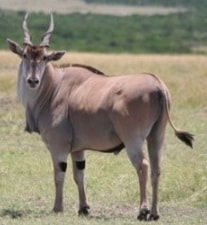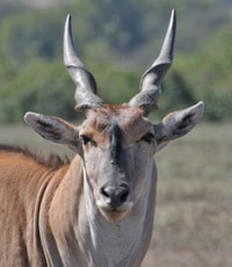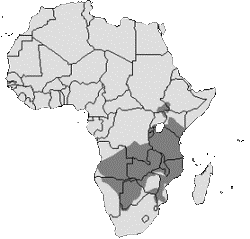Common ElandTaurotragus oryx |

Custom Search
|
|
The Common Eland (Taurotragus oryx), is also known as the Eland antelope or southern Eland can be found from Ethiopia to Angola, South Africa (Northern Cape Province), Mozambique and Namibia.
This species belongs to the Bovidae family and the genus Taurotragus. The Eland inhabits savannas and semi-desert steppes of the African continent. The Common Eland main predators include the lion, leopard, hyena and the cape hunting dog. The Common Eland antelope is one of the largest African antelope species. The coat is light brown and becomes grayish on older males only. The animals of this species have narrow white vertical stripes on the back, light and dark markings on the forelegs and a black tuft at the tail end. Adult males also have a thick mop of black hair on the forehead, rubbing the trunks and bushes with it, to mark their territory. The horns have a relatively tight spiral (measuring 120 cm in males and 65 cm in females). Females have thinner horns. There is sexual dimorphism, females are smaller than males. Females weigh around 300 to 600 kg and measure 200–280 cm in length with a height of 125–155 cm. Males weigh anywhere from 400 to 950 kg, measuring 240 to 345 in length stand 150 to 185 cm at the shoulder. The Common Eland has an average lifespan of 15 to 20 years in the wild but can live for as long as 25 years. Elands are shy animals and are considered fast for their size and have been recorded running at over 42 mph (70 km/h). They are also exceptional jumpers easily capable of jumping to a height of 5 feet (1.5 m).
This very gregarious species use a safety-in-numbers" strategy to try and avoid predators. The Eland normally lives in herds from 25 to 50 individuals, consisting of females, calves and one or more adult males, although up to 400 have been observed in a single herd. They are also seen in groups of young males or females with cubs and can form herds of hundreds of individuals during the seasonal migrations. Adult males can live alone. Common elands are mostly active during the morning and late afternoon and find shelter during the day to avoid the hottest parts of the day. Subspecies / Etymology / Taxonomy There are no subspecies currently recognized for the Common Eland. These African antelopes were first described in 1766 by Peter Simon Pallas (1767–1810) a Prussian zoologist and botanist. Diet / Feeding They feed on leaves, shoots, herbs, roots, and tubers. The common Eland travels long distances if water resources become unavailable. Reproduction The breeding season varies with geographic location. Males fight each other for the right to mate with females in heat. The gestation period is 254 to 277 days, after which only a calve normally arises, which is breastfed for four to five months of age. After birth calves will stay in concealment for a short period before joining a nursery with other young elands. The calf can run and follow the mother a few hours after birth. Females and juveniles tend to group together. The Common Eland females reach sexual maturity between 1 and 3 years old, while male takes longer needing 4 to 5 years. Conservation status and main threats It is a species at risk but not endangered, it is conservation dependent (according to the International Union for Conservation of Nature). Hunting for meat and trophy and habitat destruction are the main threats. Common Elands have been domesticated in some African countries like Kenya, Zimbabwe and South Africa, as well in Europe in countries like England, Ukraine, and Russia. They are bred for their meat, milk, and leather. Despite not yet in danger of being extinct, its population numbers are decreasing.
|
Scientific classification
Kingdom: Animalia Phylum: Chordata Class: Mammalia Order: Artiodactyla Family: Bovidae Subfamily: Alcelaphinae Genus: Connochaetes Species: C. gnou |



